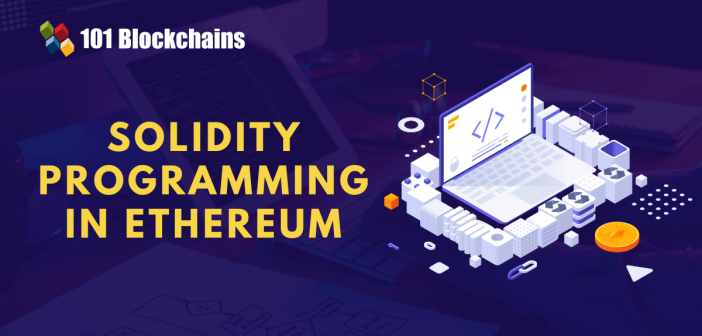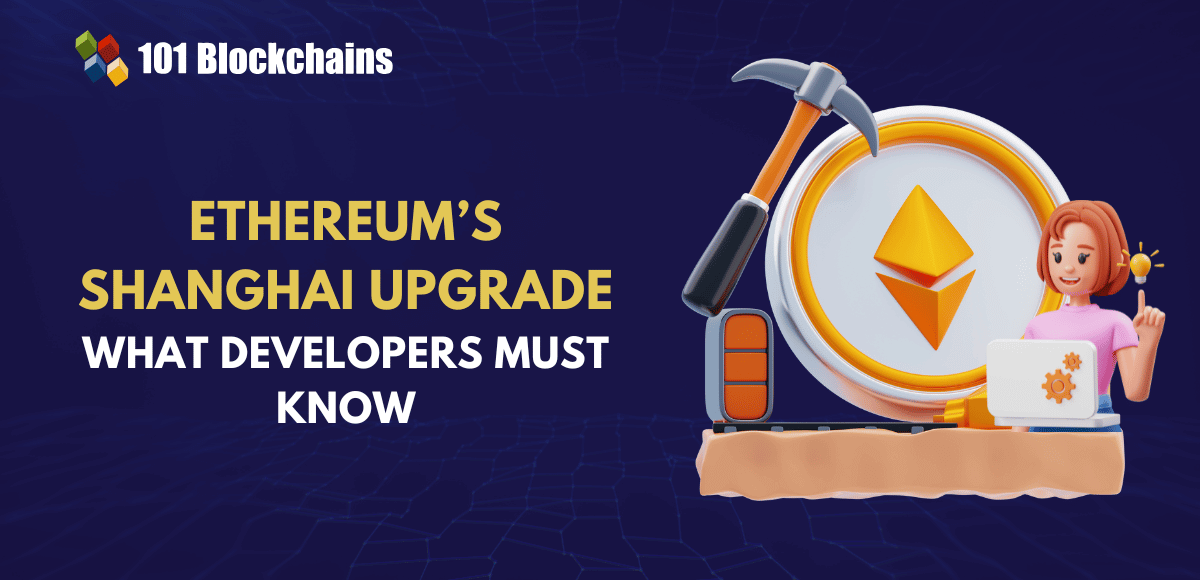Learn how blockchain truly works, master key definitions, and uncover what makes smart contracts so "smart." Dive into the fundamentals, gain valuable insights, and start your blockchain journey today!

- Ethereum
Georgia Weston
- on August 02, 2022
Know Everything About Solidity Programming in Ethereum
Decentralized applications have evolved as the next important stage in the evolution of digital solutions. They have introduced the possibilities for many new solutions for use cases in different industries alongside encouraging the DeFi ecosystem. How is Solidity programming in Ethereum relevant for decentralized applications? As a matter of fact, most of the decentralized applications are developed on the open source and decentralized Ethereum blockchain.
Solidity serves as the programming language for decentralized applications, thereby validating its relationship with Ethereum. The following discussion offers a detailed guide on the basics of Solidity programming and its important concepts. You can also learn about the methods for getting started with Solidity programming with detailed steps.
Are you aspiring to learn the fundamentals of the Ethereum Virtual Machine and smart contracts’ upgradability? Enroll now in the Advanced Solidity Development Course.
Definition of Solidity Programming
Watch the video Now to dive deeper into the fundamentals of Solidity
One of the first things in any discussion about Solidity would obviously point at possible answers for “What is Solidity Programming?” and its significance. Decentralized applications are just like any other software or application, and they need a programming language to execute code required for their system.
Solidity is the primary programming language for developing smart contracts on Ethereum blockchain. One of the important highlights of the Solidity Ethereum connection refers to the fact that Solidity is a contract-oriented language. As a result, smart contracts are accountable for storing the programming logic interacting with the blockchain.
The statically typed, high-level programming language features considerable similarities to popular languages such as Python, C++, and JavaScript. Most important of all, Solidity has been tailored for working on the Ethereum Virtual Machine or EVM, hosted on Ethereum nodes associated with the blockchain.
Basically, the importance of Solidity programming for Ethereum blockchain rests in the capability of developing industry-grade blockchain applications. It has been created by the Ethereum Network team, particularly for designing and creating smart contracts on blockchain platforms.
Solidity helps in creating smart contracts, which can ensure implementation of business logic followed by generating a chain of transaction records within the blockchain system. The primary functionality of Solidity focuses on developing machine-level code alongside facilitating compilation of the code on Ethereum Virtual Machine or EVM. The design of Solidity is also similar to other programming languages, and it includes variables, classes, arithmetic operations, functions, string manipulation, and other concepts.
Build your identity as a certified blockchain expert with 101 Blockchains’ Blockchain certifications designed to provide enhanced career prospects.
Growth of Solidity Programming
The growth of Solidity programming in Ethereum is another important highlight in an introduction to the smart contract development language. It is a comparatively new language growing rapidly with many conclusive improvements. Presently, it is the core language for developing smart contracts on Ethereum.
In addition, it also helps in smart programming contracts for other private blockchain networks on competing platforms such as Monax. Monax uses the Hyperledger Burrow blockchain, which relies on the Tendermint protocol for ensuring consensus. Furthermore, SWIFT has also developed a proof of concept which runs on the Burrow blockchain and leverages the Solidity programming language.
Importance of EVM and Smart Contracts
The two most critical highlights in the working of Solidity refer to EVM & smart contracts, and they help in understanding Solidity programming better. First of all, let us learn about the role of EVM for Solidity. EVM or Ethereum Virtual Machine is an integral component for operations on Ethereum blockchain. It serves the runtime environment required for processing Ethereum smart contracts.
The core objective of EVM focuses on ensuring security from untrusted programs by leveraging a global network of public nodes. The most striking highlight of EVM is evident in the prevention of Denial of Service or DoS attacks. EVM ensures that the decentralized applications cannot access the state of each other while establishing suitable channels for communication without any interruptions.
The next important aspect you need to learn to Get Started with Solidity Programming would point at smart contracts. Smart contracts are an essential component of the Ethereum ecosystem. They are basically high-level programming codes that are subject to compilation into the EVM before posting on Ethereum blockchain for facilitating execution.
Smart contracts bring additional value advantages by enabling the options for conducting credible transactions without any third parties. Interestingly, transactions associated with smart contracts are irreversible in nature and provide considerable ease of traceability. Solidity is one of the programming languages used for creating and scripting smart contracts. Some of the other common programming languages used for smart contract development include Mutan, LLL, and Serpent.
Excited to build your skill in Ethereum development by leveraging the ethers.js library? Enroll Now in Ethers.Js Blockchain Developer Course!
Solidity Data Types
The design of Solidity programming language features many similarities with the popular high-level languages such as C++. Python and JavaScript. As an object-oriented programming language, the data types in Solidity are similar to other OOP languages. Some of the common data types supported in OOP languages you can find with Solidity include Boolean, Integer, String, Array, and Modifier.
- Boolean data type evaluates the conditions and returns ‘1’ upon verifying truth of the condition or ‘0’ upon identifying a false condition.
- The Integer data type in Solidity serves the functionality to sign or unsign integer values with Solidity. Integer data type also provides support for runtime exceptions as well as ‘uint256’ and the ‘uint8’ keywords.
- The String data type in Solidity programming for Ethereum blockchain includes the use of single or double quotes for classifying data as a string.
- Modifier is another crucial data type in Solidity programming language for its role before execution of the smart contract code. The modifier is responsible for verifying that a specific condition is rational before executing the code.
- The syntax for Array data types in Solidity is similar to that of other OOP languages, especially with the support for single as well as multidimensional arrays.
Another significant highlight in the design of Solidity refers to the facility for mapping data structures with hash values, enums, and operators for returning values in particular storage locations.
Excited to learn about the key elements of Solidity? Check the presentation Now on Introduction To Solidity
Best Way to Start Using Solidity
The basics of Solidity in Ethereum can encourage anyone to start designing and creating smart contracts on Solidity. However, it is also important to learn the best practices for getting started with Solidity programming. Most important of all, you need to start with the basic approaches to interact with Solidity. Here are some of the interesting examples of basic code in Solidity programming, along with their significance.
-
Version Pragma
The guide on leveraging Solidity programming in Ethereum would obviously refer to version pragmas and their benefits. Pragmas in Solidity basically serve the directives to the compiler regarding methods for managing code. Therefore, it is important to add a ‘version pragma’ at the beginning of every line of source code in Solidity programming language.
The version pragma offers specifications of the version of Solidity compiler suitable for the code. The version pragma is an important highlight for EVM & smart contracts functionality in Solidity. It helps in preventing incompatibility of the code with future versions of the compiler, which might feature significant changes.
-
Contract Keyword
The “Contract” keyword is another important requirement to get started with Solidity programming and its functions. The keyword helps in declaring a contract which would facilitate encapsulation for the code.
-
Declaring State Variables
The state variables are an important class of variables in Solidity programming. State variables on Ethereum blockchain go into permanent maintenance in the smart contract storage. You can declare a state variable named ‘var1’ as a uint type with the line “uint public var1”. The var1 state variable, in this case, would be an unsigned 256-bit integer. It is important to know that declaring state variables is more like introducing additional slots in a database.
-
Declaring Functions
Another notable basic practice in guides on “What is Solidity programming?” would refer to declaring functions. Take the following example of Solidity programming code for declaring a function –
function set(uint a, uint b) public
function get() public views return (uint)
In this example, you can notice the function termed “set.” It is an access modifier type public function and uses variables ‘a’ and ‘b’ with the uint data type as parameters. The example of a simple, smart contract like this would focus on updating the value of var1 and var2. At the same time, users who can access Ethereum blockchain could use the “set” function for modifying values of var1 and var2. Furthermore, addition of the values of var1 and var2 variables could help in calculating the variable sum. In addition, the smart contract would also help in retrieving and printing the value of the state variable sum by leveraging the “get” function.
Learn the process of creating and deploying smart contracts on the Ethereum blockchain with the Solidity Fundamentals Course.
Executing Code in Solidity Programming
Your knowledge of Solidity programming for Ethereum blockchain also depends on how well you can familiarize with execution of Solidity programs. You can find two distinct methods for executing a Solidity program, such as through online and offline modes. Let us take a look at the methods for executing a Solidity program in detail.
-
Offline Mode
The first choice for operating Solidity EVM smart contracts refers to the offline mode of operations. However, it is important to follow three important conditions before you try executing a Solidity smart contract in offline mode. The first important condition for operating a Solidity smart contract in offline mode is to download and install node.js. You must also install Truffle and Ganache-CLI as the prerequisites for operating smart contracts on Solidity in offline mode. How do you execute Solidity smart contracts in offline mode? Here are the important steps you should follow for executing Solidity smart contract code in an offline state.
- Develop a Truffle project and establish a reliable development network for the same.
- Work on developing and deploying a smart contract for the project.
- Engage with the smart contract through different interactions from the Truffle dashboard.
- Develop tests for evaluation of the primary features of Solidity.
-
Online Mode
The process for using Solidity programming in Ethereum also offers the flexibility for executing code in online environments. Remix IDE serves as the best choice for anyone interested in compiling and running Solidity smart contracts.
Familiarize yourself with the second-most-popular blockchain network and Ethereum with Ethereum Skill Path
Data Structures in Solidity
You cannot miss out on data structures in a guide to get started with Solidity programming, as they serve crucial functionalities. One of the first data structures refers to the Enum data structure, which helps in maintaining track of the enumerated lists in Solidity programming language. Structs are another example of popular data structures, which help in defining your own data types. Structs can basically help you in modeling any type of data according to requirements with the arbitrary attributes of different data types. Similarly, you can also come across Arrays as one of the significant entries among data structures in Solidity programming.
The biggest surprise for people interested in “What is Solidity programming?” would obviously refer to the “Mappings” data structure. Mappings in Solidity help in storing key-value pairs and are an integral highlight in functions of the programming language. The “Mappings” data structure in Solidity works more like a hash table or associative array related to other functions.
Function Visibility
The guides on Solidity programming would also shed light on the importance of function visibility. It plays a crucial role in defining the scope of the smart contract functions in Solidity programming language. For example, the public function visibility enables ease of calling the function through accounts outside the smart contract. Subsequently, internal visibility is also helpful for creating functions that can be used only within smart contracts.
Benefits of Solidity Programming
The feasibility of Solidity programming for Ethereum blockchain depends a lot on the value advantages it delivers. Other than the basic functionalities, Solidity offers many interesting features which verify that it is a better option than many Ethereum-based programming languages. The first benefit of Solidity programming refers to the support for complicated data types and member variables alongside the fundamental data types.
Furthermore, Solidity programming language also offers an Application Binary Interface or ABI for enabling data type safety. The ABI could help in quick identification of errors when the compiler recognizes any data type mismatch for specific variables. Another popular highlight of Solidity programming in Ethereum points towards the effect of ‘Natural Language Specification.’ Solidity leverages the Natural Language Specification for transforming user-centric specifications into a language that is comprehensible to machines.
The other critical advantages of using Solidity to build decentralized applications and smart contracts would include the following,
- Easy access to object-oriented attributes in smart contracts, such as multi-level inheritance traits.
- Solidity supports multiple variants of supporting roles by leveraging the Application Binary Interface or ABI.
- The easier syntax helps beginners in learning the fundamentals of smart contracts and blockchain development.
- Development of smart contracts on Solidity programming language would help in driving secure and trustworthy processes for various platforms dealing with agreements between two parties.
Master the art of Smart Contract development with Solidity to create innovative web3 applications for diverse use cases as a Solidity expert with Solidity Skill Path
Bottom Line
The discussion on basics of Solidity programming showcases many insights into how it works. Solidity is a popular programming language on Ethereum for developing smart contracts. The similarities of Solidity with renowned high-level languages provide an exceptional opportunity for beginners to learn smart contract development.
Anyone interested in exploring the functionalities of blockchain technology in decentralized application development could learn Solidity programming language. However, it is important to review all the methods for using basic functionalities in Solidity. You need to learn about each and every component of Solidity before you can dive further into Solidity programming. Start looking for reliable sources of information on programming with Solidity to create your first smart contract.





